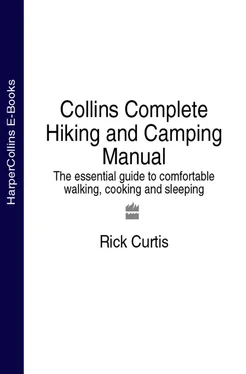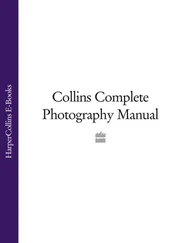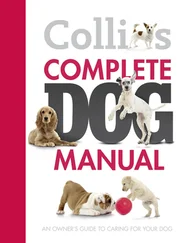COPYRIGHT Copyright Introduction CHAPTER 1 Trip Planning CHAPTER 2 Equipment CHAPTER 3 Cooking and Nutrition CHAPTER 4 Hygiene and Water Purification CHAPTER 5 Leave No Trace Hiking and Camping CHAPTER 6 Wilderness Travel CHAPTER 7 Weather and Nature CHAPTER 8 Safety and Emergency Procedures CHAPTER 9 First Aid and Emergency Care CHAPTER 10 Outdoor Leadership Appendix Bibliography Index Acknowledgements About the Publisher
First published in 2007 by
Collins
An imprint of
HarperCollins Publishers
77–85 Fulham Palace Road
London
W6 8JB
www.harpercollins.co.uk
Collins is a registered trade mark of HarperCollins Publishers Ltd
First edition 2007
Copyright © 1998, 2005 by Rick Curtis and Princeton University
Illustrations copyright © 1998, 2005 by Ron Hildebrand and Rick Curtis
All rights reserved.
Originally published in the United States by Three Rivers Press, an imprint of the Crown Publishing Group, a division of Random House, Inc., New York.
The publisher gratefully acknowledges permission to reprint excerpts from Mountain Safety, Research Inc.’s instructions for the Whisperlite stove and for artwork illustrating the Whisperlite stove; Arc’teryx for providing a backpack for the cover art; the Leave No Trace Center for Outdoor Ethics for permission to use the Leave No Trace logo; MapTech, Inc. for U.S.G.S. quadrangle maps generated from MapTech Terrain Navigator Pro; Sierra Club Books for excerpts from Weathering the Wilderness, by William E. Reifsnyder; artwork showing the SAM splint from the Seaburg Company; the MapTools UTM grid artwork from John Carnes at MapTools.com; The Physician and Sports Medicine Journal for excerpts from the article “Self-reduction of Anterior Shoulder Dislocation” by Dr. Elizabeth Joy (November 2000); Prentice Hall for an illustration of the Situational Leadership Model from Management of Organizational Behavior by Paul Hersey, Kenneth Blanchard, and Dewey Johnson.
Rick Curtis asserts his moral right to be identified as the author of this work. All rights reserved under International and Pan-American Copyright Conventions. By payment of the required fees, you have been granted the nonexclusive, nontransferable right to access and read the text of this e-book on-screen. No part of this text may be reproduced, transmitted, downloaded, decompiled, reverse-engineered, or stored in or introduced into any information storage and retrieval system, in any form or by any means, whether electronic or mechanical, now known or hereinafter invented, without the express written permission of HarperCollins e-books.
HarperCollinsPublishers has made every reasonable effort to ensure that any picture content and written content in this ebook has been included or removed in accordance with the contractual and technological constraints in operation at the time of publication.
A catalogue in publishing record for this book is available from the British Library
Source ISBN: 9780007247639
Ebook Edition © JULY 2014 ISBN: 9780007598113
Version: 2014-07-09
CONTENTS
Cover
Title Page
Copyright
Introduction
CHAPTER 1 Trip Planning
CHAPTER 2 Equipment
CHAPTER 3 Cooking and Nutrition
CHAPTER 4 Hygiene and Water Purification
CHAPTER 5 Leave No Trace Hiking and Camping
CHAPTER 6 Wilderness Travel
CHAPTER 7 Weather and Nature
CHAPTER 8 Safety and Emergency Procedures
CHAPTER 9 First Aid and Emergency Care
CHAPTER 10 Outdoor Leadership
Appendix
Bibliography
Index
Acknowledgements
About the Publisher
INTRODUCTION
Back in 1996, when I was writing the first edition of this book, the World Wide Web was still in its infancy. Since then the Internet has revolutionized the way we search for information and interact with one another. Backpacking and outdoor sports are no exception to this, from finding hiking trails to searching for gear reviews. Backpacking and outdoor recreation, like everything else, have become “information-driven.” Your knowledge base is a key part of maximizing your enjoyment, your safety, and your stewardship of the natural world.
Since the first edition, backpacking itself has changed. Advances in gear design now mean that a seven-day trip no longer means a seventy-pound pack. We’ve expanded our comfort range in all sorts of seasons and learned how to hike thousands of miles with less than twenty pounds of gear in our packs. We can use GPS receivers to pinpoint our exact location and tell us how to hike to our next campsite. At the same time, backpackers face new challenges today. The growth of outdoor recreational sports has put millions of more people on the land. Leave No Trace practices and wilderness conservation have become increasingly important to safeguard the wild lands we all love.
With all our advances in technology, there still exists a set of core skills that people need to travel in the outdoors. We seem to forget that the earliest “backpackers,” in the United States and Canada, from native peoples to wildnerness explorers like Lewis and Clark, didn’t have Gore-Tex, polypropylene ultralight tents, and a gas stove. They survived the harshest conditions with wool, leather, canvas, and yes, even cotton, through their deep knowledge of how to take care of their own needs in the outdoors.
With all these changes it was time to write a new edition of this book. I’ve used the first edition as our main textbook for teaching new outdoor leaders at Princeton University. Other schools and outdoor programs across the country use it as a textbook for backpacking and outdoor recreation courses and as a staff field manual. The first version of this book was a twenty-page manual written for our trip leader back in 1985. The manual continued to grow each year until 1996, when I began working with Random House to produce a book-length version. This new edition brings the book up to date with changes in backpacking and expands the book to cover more aspects of outdoor leadership and education. It’s a great book for beginners who need comprehensive instruction for planning and running their own outdoor trips. For experienced hikers it’s a solid reference manual and refresher for your next trip. There are lots of good backpacking books out there, and I reference a lot of them in the Bibliography. Unlike any other book on the market, Collins Camping and Hiking Manual is designed not only to be something to read on the couch at home when you are planning your trip but also to be a manual you take with you in the field. Every part of the book is designed to allow you to get the information you need as quickly as possible.
DISCLAIMER
As a risk-management expert I know that traveling in the wilderness can be hazardous. I’ve dealt with group emergencies on the trail and had my own share of close calls. By balancing your skills, experience, and gear with the right trip you can have enjoyable and safe experiences. This book is designed to be a resource to help you on your way. It can’t be a replacement for personal experience and professional training in specialized skills such as first aid and CPR. The author, HarperCollins, and Princeton University assume no liability for any personal injury, illness, or property damage or loss that may arise out of use of this material.
Specific equipment, such as stoves and water filters, is discussed in this book. There are many other products that could have been included but were not due to space considerations. The inclusion of these items does not imply any endorsement of these products.

CHAPTER 1
Читать дальше













